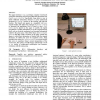Free Online Productivity Tools
i2Speak
i2Symbol
i2OCR
iTex2Img
iWeb2Print
iWeb2Shot
i2Type
iPdf2Split
iPdf2Merge
i2Bopomofo
i2Arabic
i2Style
i2Image
i2PDF
iLatex2Rtf
Sci2ools
GRAPHICSINTERFACE
2007
2007
Jump: a system for interactive, tangible queries of paper
This paper introduces Jump, a prototype computer vision-based system that transforms paper-based architectural documents into tangible query interfaces. Specifically, Jump allows a user to obtain additional information related to a given architectural document by framing a portion of the drawing with physical brackets. The framed area appears in a magnified view on a separate display and applies the principle of semantic zooming to determine the appropriate level of detail to show. Filter tokens can be placed on the paper to modify the digital presentation to include information not on the original drawing itself, such as electrical, mechanical, and structural information related to the given space. These filter tokens serve as tangible sliders in that their relative location on the paper controls the degree to which their information is blended with the original document. To address the issue of recognition errors, Jump introduces the notion of a reflection window, or an inset window...
Architectural Document | Computer Graphics | Filter Tokens | GRAPHICSINTERFACE 2007 | Tangible Query Interfaces |
| Added | 29 Oct 2010 |
| Updated | 29 Oct 2010 |
| Type | Conference |
| Year | 2007 |
| Where | GRAPHICSINTERFACE |
| Authors | Michael Terry, Janet Cheung, Justin Lee, Terry Park, Nigel Williams |
Comments (0)

